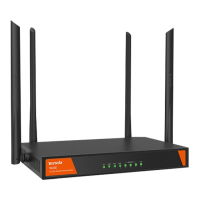43
users, and no more than 10 wireless networks nearby.
Capacity-oriented: It is applicable environment with large and spacious area, intensive users,
and over 25 wireless networks nearby.
Moderate Density: It specifies the standard operating mode of the router. It is applicable
environment with large and spacious area, intensive users, and no more than 25 wireless
networks nearby.
Low Density: It is applicable to environment with large area, multiple walls, scattered users,
and no more than 20 wireless networks nearby.
It is only available on 2.4G page. You can adjust the transmit power of the device to meet the
requirement of various application scenarios.
Coverage-oriented: it is applicable to areas with multiple walls.
Capacity-oriented: It is applicable to spacious areas with few walls. It is often used to
environment where users are intensive.
It specifies whether to enable the air interface scheduling function.
Air interface scheduling guarantees that each client shares equivalent transmission duration. If
a client with low transmission rate fails to complete transmission within the duration, it has to
wait until the next transmission time. Air interface scheduling prevents clients with low
transmission rate occupying too many resources, improving the overall efficiency of the router,
and ensuring the throughput.
Suppress
Broadcast
Probe
Response
It specifies whether to enable the broadcast probe response suppression function.
By default, wireless devices keep sending Probe Request packets that include the SSID field to
scan their nearby wireless networks. After receiving such packets, the AP determines whether
the wireless devices are allowed to access the wireless networks of the AP based on the packets
and responds using the Probe Response packets (including all Beacon frame parameters), which
consumes a lot of wireless resources.
Enable indicates that the AP does not respond to such requests, so as to save wireless
resources.
It is only available on 5G page. It specifies whether to enable the Automatic Power Save
Delivery (APSD) function. This function helps save power energy. By default, it is disabled.
It is only available on 2.4G page. it specifies the interference mitigation mode of the router.
Disable: It disables the interference mitigation.
Auto: It enables the router to automatically mitigate the interference from hardware and
ambient environment.
It specifies the wireless client disconnection interval of the router. The router disconnects from
a wireless client if no traffic is transmitted or received by the wireless client within the interval.
If the wireless client starts transmitting or receiving traffic within the interval, the countdown is
reset.
Mandatory
Rates,
Optional
Rates
Mandatory Rates: It specifies the basic rate sets for normal operation of the router. The
clients can connect to the router only when they meet the basic rate required by the router.
Optional Rates: It specifies the additional speed sets supported by the router. The clients
meeting the basic requirement can connect to the router with higher rate.
You can adjust the mandatory rates and optional rates to deny xxx clients with low rate,

